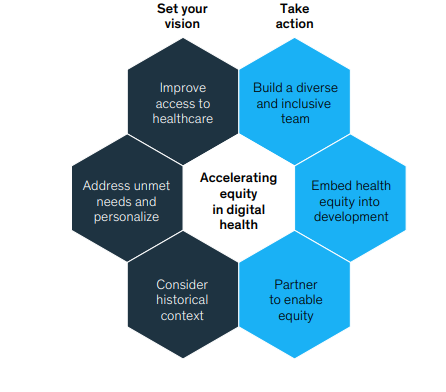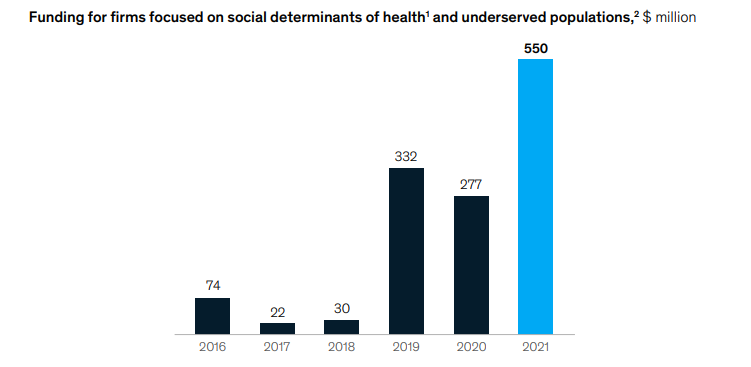world class institute
for World-Class Health Systems (WCHCS)
Joaquim Cardoso MSc.
Founder and CEO:
Researcher, Professor, Editor and Consultant (Senior Advisor)
What is the message?
Digital health solutions have the potential to advance health equity by addressing disparities in healthcare access and outcomes.
The article emphasizes the importance of leveraging technology to bridge gaps in healthcare and highlights the economic and social benefits of achieving health equity.
It also provides statistics and examples to support this message:
- Healthcare Inequity: The article acknowledges that the COVID-19 pandemic has highlighted the issue of healthcare inequity, particularly among ethnic and racial minorities, rural communities, the underprivileged, and the elderly. This is supported by the well-documented impact of the pandemic on these populations.
- Importance of Health Equity: The article emphasizes that achieving health equity is not only beneficial for individuals but also has positive effects on the larger economy.
It states that improvements in global health have contributed to about a third of all economic growth in advanced economies over the past century.
- Investment in Digital Health: The article provides statistics on venture funding for digital health companies, indicating that venture funding for digital health reached a record $29.1 billion in 2021.
It also mentions that over $0.5 billion in funding was directed toward digital health companies targeting social determinants of health and underserved populations.
- Examples of Digital Solutions: The article provides examples of digital health companies and solutions that are addressing health equity challenges. For instance, it mentions Univfy, a startup using AI to make fertility treatments more affordable, and Babylon, a telemedicine provider that improved access for patients, particularly in rural areas and underserved populations.
- Strategies for Health Equity: The article outlines strategies for digital health innovators to address health equity.
These strategies include improving access to healthcare, addressing unmet needs, considering historical context, building diverse and inclusive teams, collaborating with patients, integrating equity in commercialization, and partnering with communities.
- Benefits of Health Equity: The article underscores that digital innovators who work towards health equity can improve patient lives, enhance healthcare system efficacy, and have a positive impact on the broader economy.
In summary, the central message of the article is that digital health solutions have the potential to reduce healthcare disparities and promote health equity, and it provides statistics and examples to support this argument. It also offers strategies for digital health innovators to contribute to this important goal.

Digital health: An opportunity to advance health equity
Digital health solutions have the potential to make healthcare more equitable. Here’s how innovators can deliver on that promise.
This article is a collaborative effort by Dominique Argyres, Amy Hung, Kelsey Kennedy, Lucy Pérez, and Gila Tolub, representing views from McKinsey’s Life Sciences Practice.
July 2022
The COVID-19 pandemic, which ushered in widespread acceptance of telehealth and other digital innovations in medicine, has changed the game for the healthcare sector. Yet the pandemic has also laid bare the issue of healthcare inequity and its well-documented impact on ethnic and racial minorities, rural communities, the underprivileged, and the elderly.
Equal access to affordable and competent healthcare has the potential to improve patient outcomes by providing better quality of life, easing reliance on emergency and late-stage interventions, and reducing early deaths. Digital technologies have the potential to play a critical role in efforts to improve health equity. However, rapidly advancing technology may also exacerbate exclusion, introduce unexpected biases, widen the digital divide, and continue to leave some populations behind.
The opportunity for technology and life sciences companies that address health equity challenges with digital innovation is immense, and the downstream economic, financial, and health benefits for society are significant. Leading digital health innovators and investors explored these topics at the 2021 McKinsey Digital Health Conference on Accelerating Diversity, Equity, and Inclusion in Digital Health and offered some early case studies. By building on those topics and case studies, we propose a framework for developing and implementing digital solutions that narrow health equity gaps.

Why health equity is good for patients and business
Equalizing healthcare access and quality not only improves individual and population-level outcomes but also has salutary effects on the larger economy: good health and prompt, effective treatment allow patients to live active and productive lives. Indeed, improvements in global health have contributed to about a third of all economic growth in advanced economies over the past century. In order to sustain this growth rate, digital health solutions must be designed to reach previously excluded or underrepresented groups.
Investors in digital health solutions are beginning to take note. Venture funding for digital health companies reached a record $29.1 billion in 2021, with more than $0.5 billion in funding for digital health companies targeting social determinants of health and underserved populations (Exhibit 1). What’s more, as investors integrate environmental, social, and governance criteria into their decision making, health equity can become a core principle in planning for maximum social impact.
Exhibit 1
Innovators can accelerate equity in digital health by aligning goals and actions to levers that prioritize diversity, equity, and inclusion.

The opportunity: Addressing health equity with digital solutions
Bridging equity gaps requires significant work, and digital tools can be critical in that effort. By taking inspiration from start-ups and established leaders in the field, digital health innovators can begin to envision how their product will address health equity.
Digital tools can improve equity by increasing healthcare access, addressing unmet needs and personalizing care for patients, and considering the historical context within the communities they serve (Exhibit 2). Understanding these three areas of opportunity can help digital health innovators develop and scale their products to make a meaningful difference.
Exhibit 2
Venture funding for digital health companies targeting social determinants of health and underserved populations reached new highs in 2021.

1. Improve access to healthcare
- 1.Improve access to healthcare
- 2. Address unmet needs
- 3. Consider the historical context
1.Improve access to healthcare
Digital technology can narrow the equity gap in several ways, from streamlining difficult-to-navigate medical bureaucracy processes to eliminating travel and transportation factors from healthcare access. Access is limited by two chief constraints: affordability and availability.
High treatment costs and limited insurance coverage are well-known barriers to care. For example, health plans often have poor coverage for fertility treatments, making in vitro fertilization (IVF) prohibitively expensive for many patients. The digital health start-up Univfy is working to lower those costs in two ways: by developing an AI-based platform that predicts a patient’s probability of success and by partnering with clinics to offer refunds if IVF efforts fail.
For many patients, such as those in rural areas, the limited availability of providers and the costs associated with travel and time away from work are barriers to care. The COVID-19 pandemic spurred a rapid and significant increase in telemedicine and improved access for those who were not reliably able to attend in-person consultations. The London-based digital health service provider Babylon offers a transformative example of the power of telemedicine. Developed in collaboration with the Rwandan government in 2016, the company’s Babyl platform is designed to work with the basic phone features available to most Rwandans and, as of December 2021, has more than 2.6 million registered patients.
2. Address unmet needs
Even when patients overcome geographic and financial barriers to care, treatment options can be limited due to variation in physician knowledge and varying responses to treatments. For example, incomplete information and a mismatch between provider knowledge and the clinical presentation of disease can complicate rare disease diagnosis and treatment. This can lead to “diagnostic odysseys” that last, on average, more than five years.
Through algorithmic population screening of electronic health records, London-based Mendelian aims to decrease the time it takes to diagnose more than 100 rare diseases and connect patients with the appropriate providers.
It is also important to take into account that different populations have different needs. Maven, a New York-based virtual clinic for women’s and family health, serves populations with low technological and health literacy and partners with payers and employers to reduce or eliminate patients’ costs. The company’s on-demand virtual care allows patients to connect with a greater range of providers, increasing the possibility of pairing a patient with a provider that understands their medical and sociocultural needs.
3. Consider the historical context
Digital health companies can build trust by engaging patients via new channels. For example, the Stone Ridge, Virginia, Tigerlily Foundation provides support and education to patients, including young women and women of color, who are typically overlooked in breast cancer prevention programs. The foundation makes outreach efforts ranging from preventive care alerts to Zumba and yoga classes to better engage hard-to-reach cohorts. Providing a variety of avenues for patients to receive education and care is one way to reach a broader population and “meet patients where they’re at.” Companies must consider how past experiences shape the patient perception of a product or service and find creative ways to establish trust and understanding.
Exhibit 1
Innovators can accelerate equity in digital health by aligning goals and actions to levers that prioritize diversity, equity, and inclusion.

Taking action: Where to begin
Setting the stage for improving health equity with digital solutions is a critical first step. Digital innovators can increase their likelihood of success by incorporating emerging best practices:
- Build a diverse and inclusive team. This may involve making changes to recruitment, hiring processes, and company culture. Diverse teams are likely to bring the range of perspectives that lead to innovative and more broadly accessible products. For example, Unite Us, a technology company that builds coordinated-care networks of health- and social-service providers, hires individuals from each community it enters to ensure solutions that consider the local culture.
- Embed equity in product development. Digital innovators can prioritize diversity and inclusion at every step, from initial research and concept design to testing and implementation. When conducting research or developing algorithms, for example, it’s important to identify and account for bias in the data used to inform product design. The risk of bias is especially profound in disease areas and populations where data acquisition is challenging or flawed. To capture the multisystemic patterns and symptoms that characterize rare diseases or complex conditions, such as cancer and autoimmune disease, researchers must consider diverse data that represent all patients seeking diagnoses. Verifying data quality and comparing samples to population-level statistics can also reduce the likelihood of bias skewing results (see sidebar “Creative digital solutions to improve diversity, equity, and inclusion in clinical trials”).
- Collaborate with patients. Codeveloping products with patients ensures that the digital tool will meet their needs. Savvy Cooperative is a patient-owned cooperative that lets patients share their health experiences with companies and researchers. By listening to and working with patients, businesses and innovators can better understand the intricacies of the patient journey, which allows them to develop their products with greater sensitivity.
- Integrate equity in commercialization. Keeping patients’ different preferences for media consumption in mind throughout marketing development and deployment will help digital innovators reach a diverse patient population. It is important to have a deep understanding of the targeted groups to avoid stereotypes and create authentic content that resonates with their experience. Additionally, content creators must ensure that educational materials and instructions are inclusive of the entire patient population by considering and addressing factors such as health literacy and language barriers.
- Consider cultural context. Considering patients’ backgrounds can improve their experience with and the efficacy of a digital product, whether it’s a medical device or an interactive platform. While many digital tools integrate various language options, failing to address cultural context remains a barrier to adoption. SameSky Health of North Hollywood, California, partners with health plans to create messages customized for each patient based on their cultural background, language, and preferred mode of communication. Patients receive culturally aligned responses from a real human in one of 30 supported languages via their preferred channel. Lowering linguistic, cultural, and educational barriers helps ensure patients can complete annual wellness checks, satisfy urgent care needs, fulfill their social needs by connecting patients to one another, and manage chronic conditions.
- Partner with communities. Patients do not necessarily trust services offered by organizations outside of their community. Tools such as big data and social media can improve efficiency and efficacy, but community outreach still depends on local relationships and human connections. Community partnerships can help introduce a product or service to a population, provide community-level data that can be used to identify and track gaps in care, and support the users of new digital solutions. To do this, it is important to connect with trusted local leaders outside of the healthcare realm. For instance, researchers cite local churches and clergy as trusted conduits of healthcare information within Black communities. Digital innovators can collaborate and engage with communities via social media, neighborhood centers, schools, nurse navigators, and local congregations.

The returns on health equity
Digital innovators have an unprecedented opportunity to think more carefully about health equity and develop new solutions to entrenched healthcare problems. They must begin by considering how inequities in access limit the number of “reachable” patients and by determining which dimension of health inequity their solution could address. Then they must do the hard work of developing and implementing digital solutions that align with that health equity goal. Digital innovators who can move the needle on health equity will improve the lives of patients, increase the efficacy of healthcare systems, and have a positive impact on the greater economy.
Originally published at https://www.mckinsey.com on July 26, 2022.












